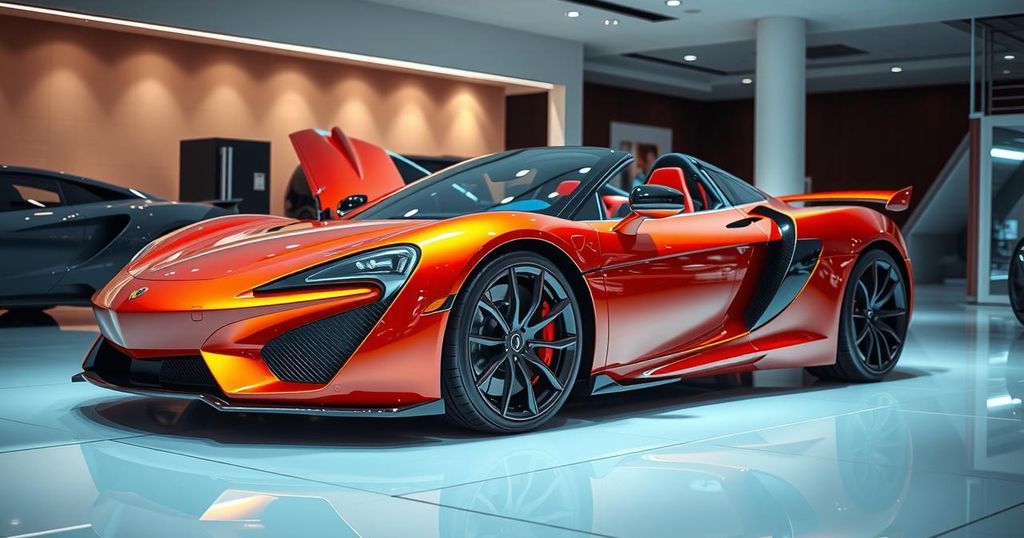Lamborghini’s Sold-Out Status in India Signals Rising Luxury Car Demand

Lamborghini’s vehicles are sold out in India until 2027 due to rising demand among young ultra-rich buyers. The luxury car market is rapidly expanding, with a projected 50% increase in ultra-rich individuals by 2028. Sales of super luxury cars double since the pandemic, indicating significant growth potential. Lamborghini and Mercedes-Benz plan to enhance their market presence with expanded dealership networks in India.
India is emerging as a focal point for ultra-luxury car sales, particularly with Lamborghini announcing that its models are sold out until 2027. The country, experiencing a surge in ultra-rich individuals (net worth over $30 million), is projected to see a 50% increase in this demographic, reaching nearly 20,000 by 2028, according to a Knight Frank study. Many of these potential buyers are young entrepreneurs eager to indulge in luxury vehicles.
Sales of super luxury vehicles in India have significantly accelerated post-pandemic, more than doubling to around 1,200-1,300 units in 2024, with Lamborghini selling over 100 units. The company’s offerings include three high-end models: Huracan, Urus, and Revuelto, with prices ranging from Rs 4 crore to Rs 8.89 crore before local taxes. As these cars are fully imported, they incur 100% customs duty, further adding to their premium pricing.
Lamborghini’s global CEO, Winkelmann, emphasized the brand’s scarcity model, stating, “Our type of business is scarcity, selling less than demand.” With a 10% sales increase from the previous year in India, the company anticipates continuous growth in 2025. Globally, Lamborghini’s sales also rose 5.7% to 10,687 units in 2024, indicative of its strong market position.
Mercedes-Benz, a competitor in the super luxury segment with its Maybach line, also experienced substantial growth in India, selling approximately 500 units last year—a 145% increase. Daniel Lescow of Mercedes-Maybach highlighted India’s place among the top ten markets worldwide, projecting it to potentially rise into the top five. The average Maybach buyer in India is notably young, at just 38 years old, aligning with Lamborghini’s demographic trends.
Winkelmann noted a significant generational shift driving demand for luxury vehicles in India, remarking, “In India, we have among the youngest customer base … they are below 40 in terms of age.” Currently, luxury cars priced over Rs 50 lakh hold a mere 1% share of the Indian market, underscoring considerable growth potential in an economy poised for rapid expansion.
Recognizing India’s unique market landscape, Lamborghini is exploring avenues for increased presence, possibly adding a fourth dealership to complement its existing locations in Delhi, Mumbai, and Bengaluru. Similarly, Mercedes-Maybach is considering additional dedicated lounges to enhance customer experiences nationwide.
Winkelmann also pointed out that improved taxes and infrastructure are essential for supporting growth. He stated, “There must be a trade-off between volumes and the taxes you can price in a country.” As India attracts a younger, more affluent clientele opting for luxury cars, Lamborghini remains optimistic about its market expansion strategy.
In summary, Lamborghini’s sold-out status in India until 2027 highlights the booming market for ultra-luxury vehicles, driven by a growing demographic of wealthy young buyers. With an expected growth in ultra-rich individuals, the luxury car market in India presents vast potential. The expansion plans of Lamborghini and Mercedes-Maybach suggest a commitment to capturing this lucrative market space, while infrastructure and taxation factors remain critical considerations.
Original Source: m.economictimes.com





